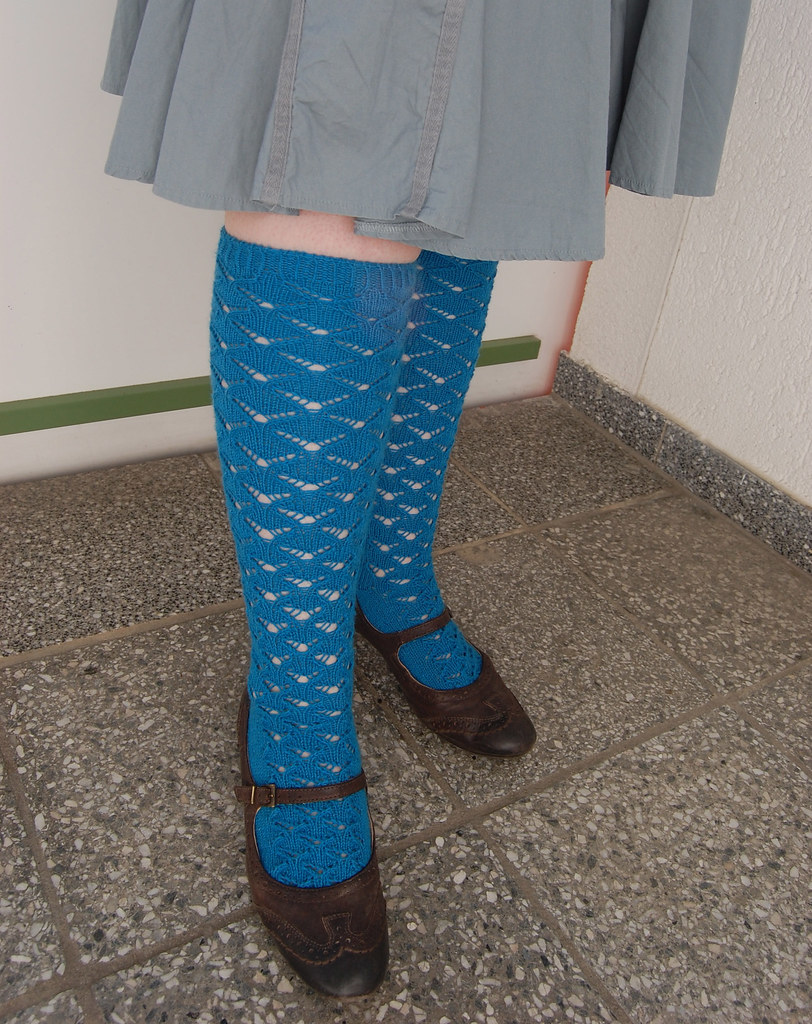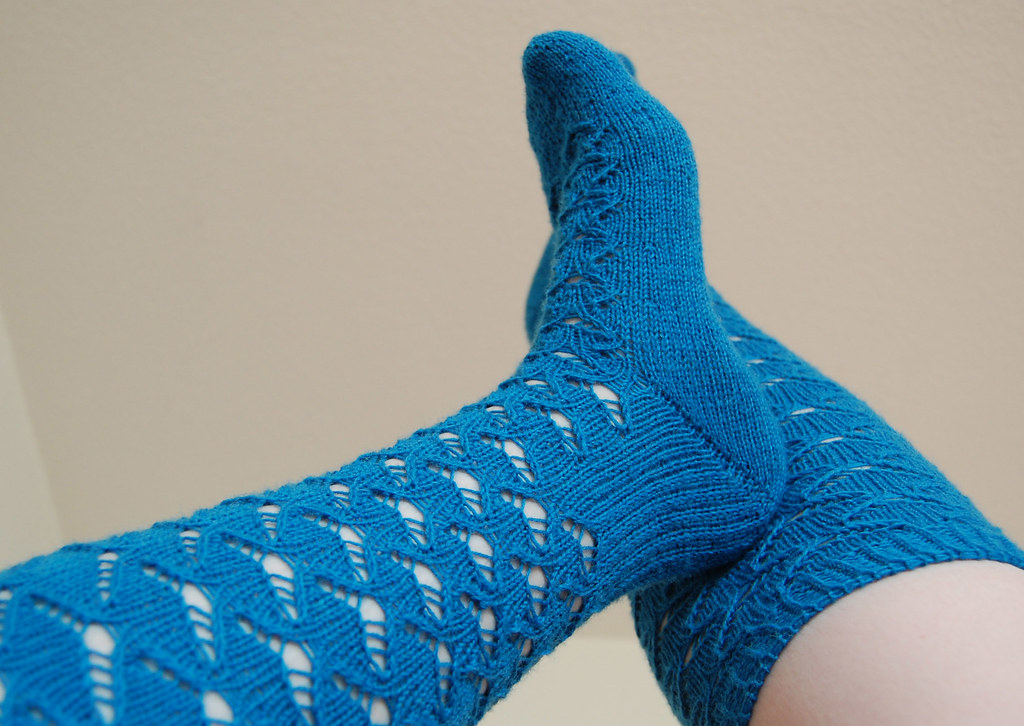
pattern: variation of the border pattern from chevron scarf by Donna Druchunas, that can be found in her book artic lace
modifications: I only worked the chart as pictured, the original pattern calls for purl rows but I skipped these. The increases were made by not decreasing in the first row of a new pattern repeat
yarn: Regia solid 4ply, yummy teal blue
needles: 2.25mm
started: 22 April 2009
finished: 1 may 2009
Yesterday I asked for some ideas for a name and Goldibug came up with Karner bue lace, which I fund to be grandious. Karner blue is a blue butterfly.

source: fish and wildlife service
I've never seen it before, which isn't surprising, since it is only common in the great lakes area of the usa, where I haven't had the chance to go yet. But it's very beautiful and I find the name very matching.
I also learned alot during the process of this stocking, it was my first toe up and so I started searching for a good cast on, and found Judy Becker's magic cast on, which is really magical. It's great and I will definitly use it again.
As I searched ravelry for casting on methods I came across a thread on anatomical correct socks, which I think is sequitur when you make your own socks, I mean you have waist shaping on shirts and jackets, calf shaping on stockings, why not shape your toes? I followed the chart that can be found here, but started with only 7 sts per needle since I only needed 56 sts total to start the foot.
I always make short row heels and use the directions from the lana grossa homepage (pdf in german and english). They call it jojo heel, I don't know if there is difference between both but it's the best tutorial I found on short rows, I don't get any holes, not even on my very first try. Only when you finished the heel and start working in the round again I learned that the gap between the nedles can result in a hole if I don't pull the first stitches tigt enough, but ladders are a common problem when working in the round so I guess it's not a result of the short rows themselves.

Again reading threads and other blogs helped to improve my heels as well, I worked the heel on appr. 60 % of the stitches not 50 % as all directions I know call for. With 50 % I find the heel to be too short.
To reinforce the heel I used the Eye of Partridge stitch. I don't know if I did it right, I believe the slipped stitches should not be on top of each other, but I liked how it looked so I stayed with it. Also I twisted the slipped sticthes when knit, which I hope means they will be even more durable, I mean I don't want to put hours of knitting into something that will have a hole soon, a sock is alot faster to finish, but knitting til the knee is a bit more time effort o_O
To bind off I used the tubular bind off, I cast on this way alot and love how professional it looks, not to mention that you can hide yarn ends in it easily. After several trials and frogging (I couldn't seem to do it right yesterday) I finally followed the directions that I saw in this video. The knitted and purled stitches are devided onto two needles before you graft them, and I think that's so clever, and easy. You can see which way the thread needs to go and you can adjust your tension alot better.
I also learned alot during the process of this stocking, it was my first toe up and so I started searching for a good cast on, and found Judy Becker's magic cast on, which is really magical. It's great and I will definitly use it again.
As I searched ravelry for casting on methods I came across a thread on anatomical correct socks, which I think is sequitur when you make your own socks, I mean you have waist shaping on shirts and jackets, calf shaping on stockings, why not shape your toes? I followed the chart that can be found here, but started with only 7 sts per needle since I only needed 56 sts total to start the foot.
I always make short row heels and use the directions from the lana grossa homepage (pdf in german and english). They call it jojo heel, I don't know if there is difference between both but it's the best tutorial I found on short rows, I don't get any holes, not even on my very first try. Only when you finished the heel and start working in the round again I learned that the gap between the nedles can result in a hole if I don't pull the first stitches tigt enough, but ladders are a common problem when working in the round so I guess it's not a result of the short rows themselves.

Again reading threads and other blogs helped to improve my heels as well, I worked the heel on appr. 60 % of the stitches not 50 % as all directions I know call for. With 50 % I find the heel to be too short.
To reinforce the heel I used the Eye of Partridge stitch. I don't know if I did it right, I believe the slipped stitches should not be on top of each other, but I liked how it looked so I stayed with it. Also I twisted the slipped sticthes when knit, which I hope means they will be even more durable, I mean I don't want to put hours of knitting into something that will have a hole soon, a sock is alot faster to finish, but knitting til the knee is a bit more time effort o_O
To bind off I used the tubular bind off, I cast on this way alot and love how professional it looks, not to mention that you can hide yarn ends in it easily. After several trials and frogging (I couldn't seem to do it right yesterday) I finally followed the directions that I saw in this video. The knitted and purled stitches are devided onto two needles before you graft them, and I think that's so clever, and easy. You can see which way the thread needs to go and you can adjust your tension alot better.
Thats strange...I am from the Great Lakes area...near Lake Superior actually but I don't recall ever seeing a blue butterfly of that nature. I must just be unlucky. :)
AntwortenLöschenCongrats on finishing the stocking!